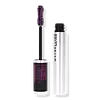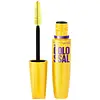What's inside
What's inside
 Key Ingredients
Key Ingredients

 Benefits
Benefits

 Concerns
Concerns

 Ingredients Side-by-side
Ingredients Side-by-side

Water
Skin ConditioningPotassium Cetyl Phosphate
EmulsifyingParaffin
PerfumingEthylene/Va Copolymer
Emulsion StabilisingCopernicia Cerifera Cera
EmollientStyrene/Acrylates/Ammonium Methacrylate Copolymer
Cera Alba
EmollientSynthetic Beeswax
Emulsion StabilisingBis-Diglyceryl Polyacyladipate-2
EmollientPolybutene
Cetyl Alcohol
EmollientSteareth-20
CleansingGlyceryl Dibehenate
EmollientSteareth-2
EmulsifyingPhenoxyethanol
PreservativeSilica
AbrasiveHydroxyethylcellulose
Emulsion StabilisingAcacia Senegal Gum
MaskingTribehenin
EmollientCaprylyl Glycol
EmollientGlyceryl Behenate
EmollientSodium Dehydroacetate
PreservativeHydrogenated Jojoba Oil
AbrasiveHydrogenated Palm Oil
EmollientPropylene Glycol
HumectantDisodium EDTA
Butylene Glycol
HumectantRayon
Sodium Laureth Sulfate
CleansingPentaerythrityl Tetra-Di-T-Butyl Hydroxyhydrocinnamate
AntioxidantPvp
Emulsion StabilisingMethylparaben
PreservativeTetrasodium EDTA
Potassium Sorbate
PreservativeBHT
AntioxidantCI 77007
Cosmetic ColorantCI 77266
CI 77491
Cosmetic ColorantCI 77492
Cosmetic ColorantCI 77499
Cosmetic ColorantCI 77891
Cosmetic ColorantMica
Cosmetic ColorantCI 75470
Cosmetic ColorantCI 77288
Cosmetic ColorantCI 77742
Cosmetic ColorantCI 77510
Cosmetic ColorantCeramide AP
Skin ConditioningWater, Potassium Cetyl Phosphate, Paraffin, Ethylene/Va Copolymer, Copernicia Cerifera Cera, Styrene/Acrylates/Ammonium Methacrylate Copolymer, Cera Alba, Synthetic Beeswax, Bis-Diglyceryl Polyacyladipate-2, Polybutene, Cetyl Alcohol, Steareth-20, Glyceryl Dibehenate, Steareth-2, Phenoxyethanol, Silica, Hydroxyethylcellulose, Acacia Senegal Gum, Tribehenin, Caprylyl Glycol, Glyceryl Behenate, Sodium Dehydroacetate, Hydrogenated Jojoba Oil, Hydrogenated Palm Oil, Propylene Glycol, Disodium EDTA, Butylene Glycol, Rayon, Sodium Laureth Sulfate, Pentaerythrityl Tetra-Di-T-Butyl Hydroxyhydrocinnamate, Pvp, Methylparaben, Tetrasodium EDTA, Potassium Sorbate, BHT, CI 77007, CI 77266, CI 77491, CI 77492, CI 77499, CI 77891, Mica, CI 75470, CI 77288, CI 77742, CI 77510, Ceramide AP
Water
Skin ConditioningParaffin
PerfumingPotassium Cetyl Phosphate
EmulsifyingBeeswax
Emulsion StabilisingCopernicia Cerifera Wax
Acacia Senegal Gum
MaskingGlycerin
HumectantCetyl Alcohol
EmollientHydroxyethylcellulose
Emulsion StabilisingSodium Polymethacrylate
Emulsion StabilisingHydrogenated Jojoba Oil
AbrasiveHydrogenated Palm Oil
EmollientPhenethyl Alcohol
MaskingPhenoxyethanol
PreservativeSteareth-20
CleansingPEG/PPG-17/18 Dimethicone
EmulsifyingPolyquaternium-10
Silica
AbrasiveSoluble Collagen
HumectantSimethicone
EmollientPanthenol
Skin ConditioningDisodium EDTA
CI 77491
Cosmetic ColorantCI 77492
Cosmetic ColorantCI 77499
Cosmetic ColorantCI 77891
Cosmetic ColorantCI 77007
Cosmetic ColorantCI 77288
Cosmetic ColorantCI 77289
Cosmetic ColorantCI 77742
Cosmetic ColorantCI 77510
Cosmetic ColorantMica
Cosmetic ColorantWater, Paraffin, Potassium Cetyl Phosphate, Beeswax, Copernicia Cerifera Wax, Acacia Senegal Gum, Glycerin, Cetyl Alcohol, Hydroxyethylcellulose, Sodium Polymethacrylate, Hydrogenated Jojoba Oil, Hydrogenated Palm Oil, Phenethyl Alcohol, Phenoxyethanol, Steareth-20, PEG/PPG-17/18 Dimethicone, Polyquaternium-10, Silica, Soluble Collagen, Simethicone, Panthenol, Disodium EDTA, CI 77491, CI 77492, CI 77499, CI 77891, CI 77007, CI 77288, CI 77289, CI 77742, CI 77510, Mica
 Reviews
Reviews

Ingredients Explained
These ingredients are found in both products.
Ingredients higher up in an ingredient list are typically present in a larger amount.
Acacia Senegal Gum has skin soothing, thickening, and formulation stabilizing properties. It comes from the Acacia tree that is native to sub-Saharan Africa.
Cetyl Alcohol is a fatty alcohol. Fatty Alcohols are most often used as an emollient or to thicken a product.
Its main roles are:
Though it has "alcohol" in the name, it is not related to denatured alcohol or ethyl alcohol.
The FDA allows products labeled "alcohol-free" to have fatty alcohols.
Learn more about Cetyl AlcoholThis pigment is called Ultramarine blue lazurite. It gives a saturated blue color, but can be used to create other colors as well.
According to the manufacturer, it is usually made from kaolin, sodium sulfate, sodium carbonate, sulfur, and charcoal.
Ci 77288 is used to add green pigment to products.
Ci 77491 is also hydrated iron III oxide. It's sole purpose is to give a red/pink hue to products.
Iron III oxides are classified as inorganic chemicals for coloring.
Synthetically created Ci 77491 is considered safer than those naturally found. This is because the synthetically created version may contain less impurities. Iron oxides are generally non-toxic and non-allergenic.
Learn more about CI 77491Ci 77492 is also hydrated iron III oxide. It's sole purpose is to give a yellow hue to products.
Iron III oxides are classified as inorganic chemicals for coloring.
Synthetically created Ci 77492 is considered safer than those naturally found. This is because the synthetically created version may contain less impurities. Iron oxides are generally non-toxic and non-allergenic.
Learn more about CI 77492Ci 77499 is also hydrated iron III oxide. It is created from mixing red and black iron oxides. This helps give shades of darkness to a product.
Iron III oxides are classified as inorganic chemicals for coloring.
This ingredient is used to impart a blue color. It is not water-soluble.
It goes by two different names:
1. Ferric Ferrocyanide: a synthetic dark blue pigment
2. Ferric Ammonium Ferrocyanide: a synthetic blue pigment, also called Prussian blue
In the EU, both of these colors must be labeled as 'CI 77510'.
Learn more about CI 77510This ingredient is used to add a violet color to cosmetics.
It is created by reacting phosphoric acid, ammonium dihydrogen orthophosphate, and manganese dioxide.
Ci 77891 is a white pigment from Titanium dioxide. It is naturally found in minerals such as rutile and ilmenite.
It's main function is to add a white color to cosmetics. It can also be mixed with other colors to create different shades.
Ci 77891 is commonly found in sunscreens due to its ability to block UV rays.
Learn more about CI 77891Disodium EDTA plays a role in making products more stable by aiding other preservatives.
It is a chelating agent, meaning it neutralizes metal ions that may be found in a product.
Disodium EDTA is a salt of edetic acid and is found to be safe in cosmetic ingredients.
Learn more about Disodium EDTAHydrogenated Jojoba Oil is created from the process of converting jojoba oil to a solid or semi-solid. Jojoba oil has occlusive and emollient properties, making it a great hydrator.
Due to the solid structure of this ingredient, it provides abrasive or exfoliating properties.
This ingredient may not be fungal acne safe.
Learn more about Hydrogenated Jojoba OilHydrogenated Palm Oil is an oil and isn't fungal acne safe.
Hydroxyethylcellulose is used to improve the texture of products. It is created from a chemical reaction involving ethylene oxide and alkali-cellulose. Cellulose is a sugar found in plant cell walls and help give plants structure.
This ingredient helps stabilize products by preventing ingredients from separating. It can also help thicken the texture of a product.
This ingredient can also be found in pill medicines to help our bodies digest other ingredients.
Learn more about HydroxyethylcelluloseMica is a naturally occurring mineral used to add shimmer and color in cosmetics. It can also help improve the texture of a product or give it an opaque, white/silver color.
Serecite is the name for very fine but ragged grains of mica.
This ingredient is often coated with metal oxides like titanium dioxide. Trace amounts of heavy metals may be found in mica, but these metals are not harmful in our personal products.
Mica has been used since prehistoric times throughout the world. Ancient Egyptian, Indian, Greek, Roman, Aztec, and Chinese civilizations have used mica.
Learn more about MicaParaffin is a solid created from petroleum. The term 'paraffin' can also refer to either
petroleum jelly or mineral oil.
It has natural occlusive properties which can worsen oily skin. Due to its petrolatum base, this ingredient is not fungal-acne safe.
Phenoxyethanol is a preservative that has germicide, antimicrobial, and aromatic properties. Studies show that phenoxyethanol can prevent microbial growth. By itself, it has a scent that is similar to that of a rose.
It's often used in formulations along with Caprylyl Glycol to preserve the shelf life of products.
Potassium Cetyl Phosphate is the potassium salt of a mixture. This mixture consists of the esters from phosphoricacid and cetyl alcohol.
Potassium Cetyl Phosphate is an emulsifier and cleansing agent. Emulsifiers help stabilize a product. It does this by preventing certain ingredients from separating.
As a cleansing agent, Potassium Cetyl Phosphate helps gather oils, dirts, and pollutants from your skin. This makes it easier to rinse them away with water.
Learn more about Potassium Cetyl PhosphateSilica, also known as silicon dioxide, is a naturally occurring mineral. It is used as a fine, spherical, and porous powder in cosmetics.
Though it has exfoliant properties, the function of silica varies depending on the product.
The unique structure of silica enhances the spreadability and adds smoothness, making it a great texture enhancer.
It is also used as an active carrier, emulsifier, and mattifier due to its ability to absorb excess oil.
In some products, tiny microneedles called spicules are made from silica or hydrolyzed sponge. When you rub them in, they lightly polish away dead skin layers and enhance the penetration of active ingredients.
Learn more about SilicaSteareth-20 is a waxy compound used to emulsify ingredients. It is created from stearyl alcohol.
It possesses surfactant properties. This means it reduces surface tension and helps oils, dirt, and pollutants to be washed away.
The 20 stands for the number of ethylene oxide used to create this ingredient.
Learn more about Steareth-20Water. It's the most common cosmetic ingredient of all. You'll usually see it at the top of ingredient lists, meaning that it makes up the largest part of the product.
So why is it so popular? Water most often acts as a solvent - this means that it helps dissolve other ingredients into the formulation.
You'll also recognize water as that liquid we all need to stay alive. If you see this, drink a glass of water. Stay hydrated!
Learn more about Water